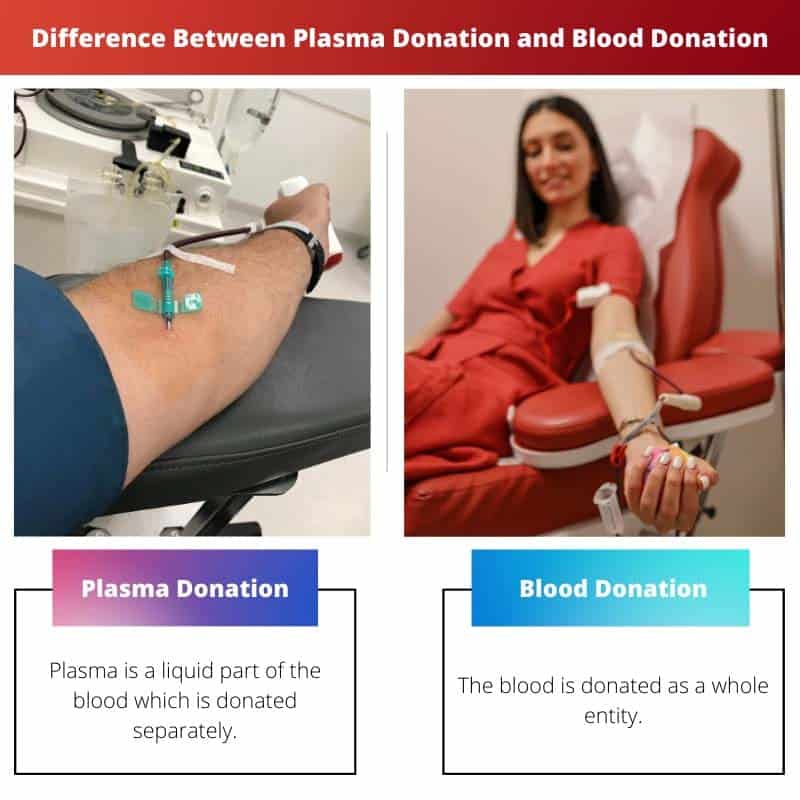Plasma Donation and blood donation are donations that are given by a person willing to give to another person o save his/her life. Plasma and Blood are part of bodies, and their lacking can lead to the death of a person.
Blood is a main component of our body system.
Key Takeaways
- Plasma donation involves extracting plasma from the blood and returning red and white blood cells to the donor.
- Blood donation collects whole blood, including all blood components.
- Plasma donations can occur more frequently, while blood donations require a longer waiting period between sessions.
Plasma Donation vs Blood Donation
Plasma donation involves donating the liquid portion of the blood, which contains important proteins and other substances that can be used to treat various medical conditions. Blood donation involves the donation of whole blood, which is collected from a vein in the arm and separated into its different components, including red blood cells, platelets, and plasma.

Plasma is a part of Blood. Blood is composed of two main contents: one is solid content called cells, and another is a liquid called Plasma. Plasma is 55% of the blood fluid.
It contains 92% of water in volume. Plasma is detached from the cells for donation.
After detaching, it becomes a yellow-coloured liquid.
Blood circulates our body through blood vessels and keeps the heart pumping. Whenever a person has a cut, the blood flows out.
A small cut will not damage the body’s system. However, more amount of blood loss can endanger a person’s life.
This led to the system of blood donation.
Comparison Table
| Parameters of Comparison | Plasma Donation | Blood Donation |
|---|---|---|
| Definition | Plasma is a liquid part of the blood which is donated separately. | The blood is donated as a whole entity. |
| Donor eligibility | The donor has to be 18 years of age and shouldn’t have transmitted diseases. And shouldn’t be pregnant as well. | Donor’s with transmitted diseases or weak health cannot donate blood. |
| Frequency | Plasma donation can be done twice a week. | The person is advised to take a gap of a minimum of 3 months. |
| Blood type | AB blood type can donate plasma to all other blood types. | O- blood type can donate blood to all other blood types. |
| Recovery | Since blood cells are returned to the donor’s body, it doesn’t need much time to recover. | It needs some time to recover as whole blood is drawn from the body. |
| Quantity | 800 milliliter of plasma can be donated by a single person one time. | 200 to 550 milliliter of blood can be drawn from a single person at one time. |
What is Plasma Donation?
Plasma is the liquid component of the blood. Blood consists of two components, cells and plasma.
Cells are considered the solid part, while plasma is the liquid component of the blood. Plasma is 55% of total blood volume.
The liquid plasma, after being detached from cells, takes yellow color.
Plasma maintains the blood pressure of the body. It also gets rid of the chemical waste from cells by dissolving and carrying it away.
Even though plasma is detached from the blood cells, it doesn’t lose its proteins, antibodies, and nutrients. In many disorders and deficiencies, the person’s blood thickens, that is, the plasma is lacking.
Therefore they need plasma to live a healthy life. Myasthenia gravis, Guillian Barre syndrome, Wilson’s disease, Hemophilia, etc., are some of the disorders in which patients need plasma.
The process of donating plasma is called Plasmapheresis. The process takes almost one and a half hours.
In this process, the plasma is taken, and the blood cells go back into your body. One person can donate plasma twice a week.
From the four main blood groups, the AB blood group can donate plasma to any other blood group, while others have to be of the same blood group.

What is Blood Donation?
Blood flows through our veins and arteries and keeps the supply of oxygen to the tissues. It regulates the blood temperature. And removes waste such as carbon dioxide, lactic acid, and urea.
The blood is a rich red. Blood is donated based on blood groups as well. The blood group are A, B, AB, and O, only O- blood can be donated to any blood group type.
Otherwise, it has to be donated as per the specific blood group of the person.
Blood loss due to the accident is very common. Blood banks are formed by the government to keep blood for emergency cases.
Usually, 200 millilitres to 550 millilitres of blood can be drawn from one person to donate.
There are two processes of donating blood. One is donating blood as a whole entity. The other is to donate a part of blood, which can be cells or plasma.
Cells consist of three parts: White Blood cells, Red blood cells, and Platelets, which can be donated separately as well. Mostly, plasma and platelets can be donated frequently.
Blood donation takes up to half an hour. The donor had to stay 10-15 minutes after the donation.
He/she is kept under observation in case any side effect occurs.

Main Differences Between Plasma Donation and Blood Donation
- Plasma is a liquid part of the blood which is donated. Plasma is separated from the cells of the blood. The blood is donated as a whole entity.
- Plasma donation can be made twice a week, while blood donation donors have to take a minimum 3-month gap.
- In plasma donation, the red blood cells are returned to the body of the donor. So it takes less time for the plasma donor to recover in comparison with the blood donor.
- The process of plasma donation takes up to one and a half an hour. The blood donation process takes just 30 minutes.
- In plasma donation, the AB blood type can donate plasma to all other blood types. In blood donation O- blood group type can donate blood to every blood type.

- https://jamanetwork.com/journals/jama/article-abstract/381535
- https://www.ncbi.nlm.nih.gov/pmc/articles/PMC3934262/
- https://onlinelibrary.wiley.com/doi/abs/10.1111/j.0958-7578.2004.00474.x

The article does an excellent job of highlighting the importance and distinctions between plasma and blood donation, offering a comprehensive overview of both types of donations.
The article effectively articulates the significance of plasma and blood donation, providing detailed information about the donor eligibility, donation frequency, and process for both types of donations.
This piece serves as a valuable source of information about plasma and blood donation, providing detailed insights into both types of donations and their impact on medical practices.
This article effectively distinguishes between plasma donation and blood donation, addressing the importance of both types of donations and their impact on medical treatments.
The article offers an insightful comparison between plasma and blood donation, highlighting the importance of these donations and the differences in donor eligibility, frequency, and recovery.
The detailed comparison between plasma and blood donation, including donor eligibility and frequency, is quite insightful and provides a comprehensive understanding of these donations.
The article provides insightful information about plasma and blood donation, emphasizing the donor eligibility criteria, frequency, and recovery aspects of each type of donation.
The clear comparison between the frequency, recovery, and the quantity of plasma and blood donation is very informative and helpful for anyone considering to donate.
The detailed comparison between plasma and blood donation in the article offers a comprehensive understanding of the importance and process of both types of donations, emphasizing their role in medical care and emergencies.
The article offers an in-depth explanation of plasma donation and blood donation, highlighting the significance of each and their respective processes. It’s quite intriguing.
The article effectively explains the process, significance, and comparison of plasma and blood donation, shedding light on the importance of these donations for medical treatments and emergencies.
The article presents a comprehensive overview of plasma and blood donation, touching on the importance and process of each. It serves as a valuable resource for understanding these donations.
The comprehensive explanation of plasma and blood donation in the article provides valuable insights into the importance and process of both types of donations.
The article effectively communicates the significance and process of plasma and blood donation, providing valuable information to raise awareness about these donations and their impact on medical treatments.
The article offers an overview of plasma and blood donation, covering crucial aspects such as donor eligibility, donation frequency, and the significance of these donations in medical conditions.
I agree, the detailed comparison table is useful to understand the differences between plasma and blood donation. It provides valuable information for those who are considering to donate.
This article offers an enlightening comparison between plasma and blood donation, presenting detailed information about the importance, process, and impact of both types of donations.
The article delivers a clear and informative comparison of plasma and blood donation, emphasizing the importance of both types of donations and their respective benefits to patients in need.
The article explains the importance of blood and plasma donations in treating various medical conditions, creating awareness about the significance of these donations in saving lives.
I find it valuable that the article emphasized the importance of blood and plasma donation, as well as the processes involved in each type of donation.
The detailed description of plasma and blood donation, including the importance and comparison between the two, offers a comprehensive understanding of these donations and their significance.